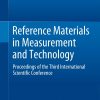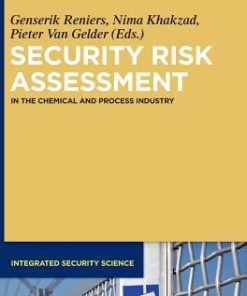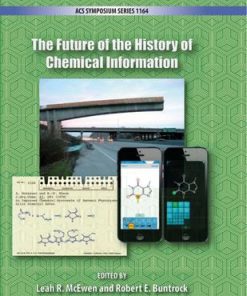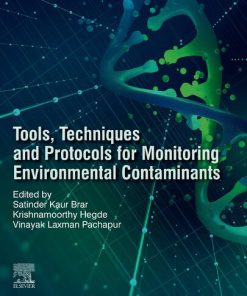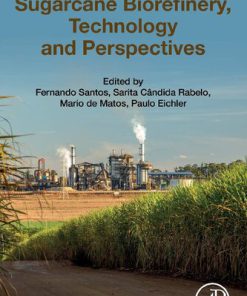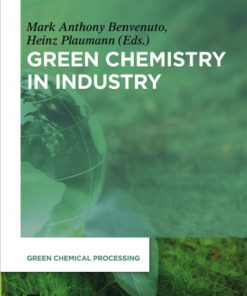Platform Chemical Biorefinery Future Green Industry 1st Edition by Satinder Kaur Brar, Saurabh Jyoti Sarma, Kannan Pakshirajan 0128030042 9780128030042
$50.00 Original price was: $50.00.$25.00Current price is: $25.00.
Platform Chemical Biorefinery. Future Green Industry 1st Edition by Satinder Kaur Brar, Saurabh Jyoti Sarma, Kannan Pakshirajan – Ebook PDF Instant Download/DeliveryISBN: 0128030042, 9780128030042
Full download Platform Chemical Biorefinery. Future Green Industry 1st Edition after payment.
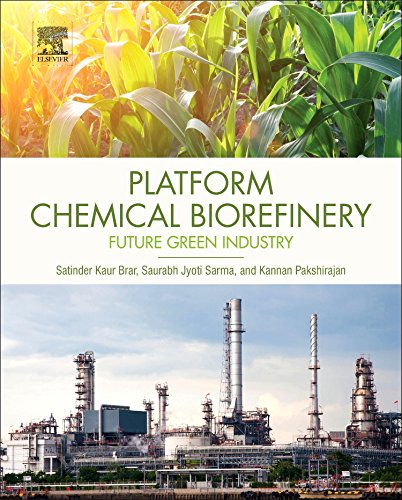
Product details:
ISBN-10 : 0128030042
ISBN-13 : 9780128030042
Author: Satinder Kaur Brar, Saurabh Jyoti Sarma, Kannan Pakshirajan
Platform Chemical Biorefinery: Future Green Chemistry provides information on three different aspects of platform chemical biorefinery. The book first presents a basic introduction to the industry beneficial for university students, then provides engineering details of existing or potential platform chemical biorefinery processes helpful to technical staff of biorefineries. Finally, the book presents a critical review of the entire platform chemical biorefinery process, including extensive global biorefinery practices and their potential environmental and market-related consequences.
Platform chemicals are building blocks of different valuable chemicals. The book evaluates the possibility of renewable feedstock-based platform chemical production and the fundamental challenges associated with this objective. Thus, the book is a useful reference for both academic readers and industry technical workers. The book guides the research community working in the field of platform chemical biorefinery to develop new pathways and technologies in combination with their market value and desirability.
Platform Chemical Biorefinery. Future Green Industry 1st Table of contents:
Chapter 1. Platform Chemicals: Significance and Need
1.1. Introduction
1.2. Commercially Important Platform Chemicals: Organic Acids
1.3. Commercially Important Platform Chemicals: Alcohols
1.4. Advances in Platform Chemical Process Engineering: Natural Microbial Synthesis
1.5. Challenges and Future of the Industry
1.6. Conclusion
Chapter 2. Biorefinery: General Overview
2.1. Introduction
2.2. Biorefinery: A Reemerging Concept
2.3. Biorefinery and Greenhouse Gas Emissions Reduction
2.4. Biorefinery for Chemical and Energy Security
2.5. Biorefinery for Sustainable Development
2.6. Concluding Remarks
Chapter 3. Petroleum Versus Biorefinery-Based Platform Chemicals
3.1. Feedstock Availability
3.2. Product Range
3.3. Nature and Extent of Environmental Pollution
3.4. Sustainability
Chapter 4. Life Cycle Analysis of Potential Substrates of Sustainable Biorefinery
4.1. Introduction
4.2. Lignocellulosic Biomass From Agriculture and Forests
4.3. Algae and Fungi
4.4. Industrial Organic Waste
4.5. Municipal Wastewater and Solid Waste
4.6. Sludge From Wastewater Treatment Plants
Chapter 5. Propylene Glycol: An Industrially Important C3 Platform Chemical
5.1. Introduction
5.2. Global Propylene Market: An Overview
5.3. Propylene Glycol and Commercial Applications
5.4. A Comparative Evaluation of Different Methods Used for Propylene Production
5.5. Sustainable Propylene Glycol Production and Challenges
Chapter 6. 3-Hydroxy-propionic Acid
6.1. Introduction
6.2. Importance of 3-Hydroxy-propionic Acid
6.3. Biotechnological Production of 3-Hydroxy-propionic Acid
6.4. Potential Feedstock for 3-Hydroxy-propanoic Acid Production
6.5. Production of Biodegradable Polymer Using 3-Hydroxy-propanoic Acid
Chapter 7. Butyric Acid: A Platform Chemical for Biofuel and High-Value Biochemicals
7.1. Introduction
7.2. Butyric Acid as a Potential Biorefinery
7.3. Production of Butyric Acid
7.4. Chemical Synthesis of Butyric Acid
7.5. General Aspects of Biological Butyric Acid Production
7.6. Microorganisms
7.7. Feedstock
7.8. Fermentation
7.9. Downstream Processing
7.10. Butyric Acid as a Platform Chemical for Promising Biofuel Butanol
7.11. Chemical Conversion of Butyric Acid to Butanol
7.12. Biochemical Conversion of Butyric Acid to Butanol
7.13. The Future of Butyric Acid in Industry
Chapter 8. Fumaric Acid: Production and Application Aspects
8.1. Introduction
8.2. Production Routes of Fumaric Acid
8.3. Molecular Biology of Fungal Morphogenesis Versus Fumaric Acid Production
8.4. Downstream Processing of Fumaric Acid
8.5. Application Aspects of Fumaric Acid
8.6. Future Perspectives and Challenges
Chapter 9. Malic and Succinic Acid: Potential C4 Platform Chemicals for Polymer and Biodegradable Plastic Production
9.1. Different Methods of Malic Acid Production
9.2. Malic Acid Production From Renewable Materials: Commercial Potential
9.3. Application of Malic Acid for the Production of Renewable Polymers
9.4. Succinic Acid Bioproduction
9.5. Succinic Acid and Its Commercial Potential for Biodegradable Plastic Production
9.6. Conclusions
Chapter 10. Potential Applications of Renewable Itaconic Acid for the Synthesis of 3-Methyltetrahydrofuran
10.1. Introduction
10.2. Methyltetrahydrofuran
10.3. Methyltetrahydrofuran Production
10.4. Recovery and Purification of Methyltetrahydrofuran
10.5. Methyltetrahydrofuran Applications
10.6. Itaconic Acid
10.7. Brief History of Itaconic Acid
10.8. Microorganisms Exploited for the Production of Itaconic Acid
10.9. Biosynthesis of Itaconic Acid
10.10. Aspergillus terreus as a Potent Producer of Itaconic Acid
10.11. Process Development Strategies for Enhanced Itaconic Acid Production
10.12. Potential Feedstocks for the Bioproduction of Itaconic Acid
10.13. Downstream Process for the Recovery of Itaconic Acid
10.14. Potential Applications of Itaconic Acid
10.15. Market Potential of Itaconic Acid
10.16. Concluding Remarks
Chapter 11. Production of Renewable C5 Platform Chemicals and Potential Applications
11.1. Introduction
11.2. Potential of C5 Platform Chemicals
11.3. Metabolic Engineering of C5 Platform Chemicals
11.4. Xylitol–Sugar Alcohol
11.5. 5-Aminovalaric Acid: Organic Acid
11.6. 1,5-Diaminopentane: Diamine
11.7. Itaconic Acid: Organic Acid
11.8. Levulinic Acid: Organic Keto Acid
11.9. Furfural: An Aldehyde
11.10. Glutamic Acid: Amino Acid
11.11. Conclusion
Chapter 12. Sorbitol Production From Biomass and Its Global Market
12.1. Introduction
12.2. A Comparative Evaluation of Different Renewable Feedstocks Used for Sorbitol Production
12.3. Downstream Processing of Sorbitol
12.4. Global Production and the Sorbitol Market
12.5. Sorbitol and Its Major Applications
12.6. Conclusions
Chapter 13. Sugar-Derived Industrially Important C6 Platform Chemicals
13.1. Introduction
13.2. Glucaric Acid
13.3. 2,5-Furandicarboxylic Acid
13.4. Gluconic Acid
13.5. Sorbitol
13.6. Conclusion and Future Outlook
Chapter 14. Production of Drop-In and Novel Bio-Based Platform Chemicals
14.1. Possibility and Challenges of Drop-In Chemicals Production
14.2. Role of Chemical Catalysis in Drop-In Chemical Production
14.3. Lactic Acid: A Commercially Important Drop-In Platform Chemical
14.4. Bio-Polyethylene Terephthalate: Production and Technical Challenges
14.5. Novel Bio-Based Platform Chemicals
Chapter 15. Platform Chemicals and Pharmaceutical Industries
15.1. Introduction
15.2. Isosorbide
15.3. Cyanophycin, Aspartic Acid, and Arginine
15.4. Hydroxymethyl Furfural
15.5. Glycerol
15.6. Acetaldehyde
15.7. Future Strides
15.8. Conclusions
Chapter 16. Biorefinery and Possible Deforestation
16.1. Introduction
16.2. Forest-Based Feedstock for Biorefinery
16.3. Applications of Forest Resources as Biorefinery Feedstocks
16.4. Remedial Measures
16.5. Extensive Land Use for the Production of Biorefinery Feedstock and Deforestation
16.6. Conclusions
Chapter 17. Biorefinery and Possible Negative Impacts on the Food Market
17.1. Introduction
17.2. Classification Scheme and Complexity
17.3. Food Materials Used in Biorefinery
17.4. Present Global Production and Demand of Biofuels and Bio-Based Chemicals
17.5. Projected Demand of Food-Grade Materials In Biorefinery for the Next 20Years
17.6. Possibility of Increased Food Prices due to Extensive Biorefinery Practices in the Future
17.7. Conclusion
Chapter 18. Algal Biorefinery for High-Value Platform Chemicals
18.1. Introduction
18.2. Potential Products of Algal Biorefinery
18.3. Algae Cultivation Process Engineering for Energy and Chemicals
18.4. Conclusions
Chapter 19. Animal Fat- and Vegetable Oil-Based Platform Chemical Biorefinery
19.1. Global Production of Animal Fat and Vegetable Oil
19.2. Biodiesel Production
19.3. Direct Application of Fat and Oil for Platform Chemical Production
19.4. Potential Market of Fat- and Oil-Derived Platform Chemicals
19.5. Conclusion
Chapter 20. Platform Chemical Biorefinery and Agroindustrial Waste Management
20.1. Introduction
20.2. Agroindustrial Waste Types and Their Global Annual Production
20.3. Present Agroindustrial Waste Management Approaches
20.4. Advantages and Challenges of Using Agroindustrial Wastes as the Feedstock for Biorefinery
20.5. Agroindustrial Waste Biorefinery: Engineering Breakthroughs
20.6. Conclusions
Chapter 21. Integrated Biorefinery for Food, Feed, and Platform Chemicals
21.1. Introduction to the Biorefinery Concept
21.2. Current Biofuels Scenario
21.3. Nonrenewable and Renewable Resources
21.4. Green Chemistry Inspiration
21.5. Platform Molecules
21.6. Importance of Catalysts in Biomass Conversion for Food, Feed, and Platform Chemicals
21.7. Conclusion
Chapter 22. Integrated Biorefinery for Bioenergy and Platform Chemicals
22.1. Integrated Biorefinery of Biodiesel and Platform Chemicals
22.2. Integrated Biorefinery of Bioethanol and Platform Chemicals
22.3. Integrated Biorefinery of Platform Chemicals and Biogas Production
22.4. Agroindustrial Wastes as Feedstock for Bioenergy and Platform Chemicals
Chapter 23. Microbiology of Platform Chemical Biorefinery and Metabolic Engineering
23.1. History and Current Scenario of Fossil Fuels
23.2. Origin, Definition, and Types of Biorefineries in the World Scenario
23.3. Application of Microbiology in Biorefineries
23.4. Metabolic Engineering of Microorganisms in Biorefinery
23.5. Omics Data for Various Environmental and Genetic Perturbations
23.6. Conclusion
Chapter 24. Enzymes in Platform Chemical Biorefinery
24.1. Introduction to Enzymes and Their Modes of Action
24.2. Chemical Catalysis Versus Biocatalysis
24.3. Advantages of Biocatalyst-Based Processes
24.4. Importance of Biocatalysts Over Chemical Catalysts
24.5. Enzymes in Biorefinery
24.6. Pretreatment Process in Biorefinery
24.7. Enzymatic Activity in the Pretreatment Process
24.8. Cellulose Degradation
24.9. Hemicellulose Treatment
24.10. Why Modern Era Industries Prefer Enzymes Over Conventional Chemicals?
24.11. Classification of Lignocellulose-Degrading Enzymes
24.12. Enzyme Technology in Biorefineries
24.13. Development of New Enzymes for Effective Biorefinery Operation
24.14. Conclusion
Chapter 25. Process Design and Optimization for Platform Chemical Biorefinery
25.1. Introduction
25.2. Production of C3 Platform Chemicals
25.3. Coproduction of 3-Hydroxy-propionic Acid and 1,3-Propanediol
25.4. Conclusion
Chapter 26. Case Studies on the Industrial Production of Renewable Platform Chemicals
26.1. An Overview of Different Renewable Platform Chemicals Produced at Industrial Scale
26.2. Nature of the Processes, Feedstock Conversion, and Product Recovery Efficiency
26.3. Change of Production Volume Over Time
26.4. Product Quality and Process Cost
26.5. Present Applications and Potential Market
26.6. Conclusion
People also search for Platform Chemical Biorefinery. Future Green Industry 1st:
what is inorganic chemical industry
platform chemical
platform chemicals
platform chemical meaning
platform chemicals list
Tags: Platform, Chemical Biorefinery, Future Green, Industry, Satinder Kaur Brar, Saurabh Jyoti Sarma, Kannan Pakshirajan
You may also like…
Engineering
Business & Economics
Business & Economics - Industries
The Indian Hospitality Industry Dynamics and Future Trends 1st Edition Sandeep Munjal
Computers - Computer Business & Culture
The Future Was Here The Commodore Amiga Platform Studies Maher
Chemistry - Technical & Industrial Chemistry



